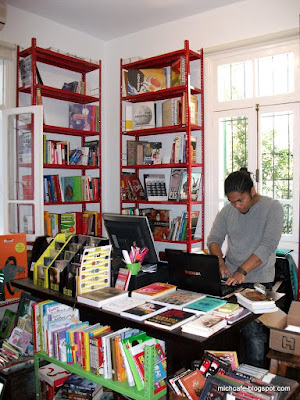 |
| Dar Bistro and Books |
My greatest pleasure when in
Beirut is to walk everywhere and greet and be greeted left, right and center. Each
time I am there, I notice new cafes, restaurants, shops and galleries sprouting
in the city and the streets getting all the more busier well after midnight.
My discovery and favorite
venue this trip was Dar Bistro and Books.
I heard so much about it that
I went to check it out one afternoon with my cousin Lillian. And what a
pleasant surprise it was!
 |
| Jasmine you can smell throughout the Dar garden |
 |
Dar is tucked away in a little side street in Wardieh Square, just after the petrol station. You can easily miss it if you don’t notice the signboard. It’s at the end of the cul-de-sac, in an old, traditional two-floor house set in a garden overflowing with jasmine and bougainvillea.
When you enter Dar, which is
owned by Rima Abushakra, Dima Abulhusn and Ramzi Haidar, you leave the hustle and bustle of Hamra Street and step
into a village house and garden.
I first heard about Dar on arrival in Beirut in mid-November, because it ran into
some trouble recently and many friends thought it had closed down. It seems the
BBC
Beirut correspondent, who lives close to Dar, lobbied his political connections
to shut it down.
 |
| Keeping the noise down |
The
noise from
cafes, restaurants
and bars is one that residents all over Beirut are facing, including in Hamra,
Monot and Gemmayzeh. It is all the more acute as patrons spill out onto the
street and the outdoor seating areas since the no-smoking ruling came into
effect a couple of months ago.
A
couple of days later, we went
back for dinner to introduce Dar to my sister Asma. The three of us enjoyed a yummy
dinner, sitting outside in the garden, of four different plates that we shared.
Riad, the manager, or Rima Abushakra, the owner, always greet you warmly.
 |
| The delicious meal we enjoyed... |
 |
| ... sitting outside |
 |
| The Dar bookstore |
 |
| I met Ibrahim Nehme and got a copy of The Outpost |
Dar Al Mussawir
On the floor above the bistro and
bookstore, Dar hosts exhibitions and Dar Al Mussawir, a center that deals with all aspects of professional and
amateur photography. It’s there that professionals and hobbyists can work on
their projects and encourage the spread of photography.
 |
| Some vintage photography equipment... |
 |
| ... and more cameras at Dar Al Mussawir |
Dar Al Mussawir provides learning
opportunities as well as equipment. It houses a darkroom, photo printing
facilities, gallery space, a library of books and material on photography, a
studio, and a room for photography training workshops.
 |
| I was kindly offered a copy of Lahza... |
 |
| ... and a tour of the center by Ibrahim Dirani |
In Lahza (Arabic for glimpse), 500 disposable cameras
were provided to 500 Palestinian children aged six to 12, living in Lebanon’s
12 Palestinian refugee camps, to capture their everyday lives. Out of 13,000
captured photos, Zakira published a
collection of 141 photos in a book that I was very kindly offered while
visiting the center. The photos by the children are some of the best I have
seen of life in the camps.
After Lahza
provided advanced photography training to 250 marginalized Lebanese and
Palestinian aged 14 to 18, focusing on dropouts and undereducated youth. The
aim was to introduce the various communities to each other and provide them
with photography as a tool to earn a living.
I have never seen so many cameras in one space and felt awkward taking
pictures with my little digital thing. But I got the grand tour by Ibrahim
Dirani and will treasure my Lahza
gift.
Samir Kansoe exhibition
On exhibit at Dar Al Mussawir was Lebanese painter Samir Kansoe.
I bumped into him on the second floor balcony and we got chatting about his
paintings.
 |
| Samir Kansoe with one of his paintings |
He began painting in black and white, and is now at his 16th exhibit,
most of which were in Arab countries. His November 15-December 1 show in Beirut
was his first and a start in the Lebanese capital he had shunned because he
thought galleries were in it to just sell rather than display the art and
introduce it to the public.
 |
| Kansoe black and white paintings |
 |
| The upstairs balcony at Dar... |
 |
| ... looking down on the garden |
Kansoe still finds it awkward to make money out of putting colors on
paper. He doesn’t always draw, collecting his ideas in his head and then
executing them.
 |
| I look forward to my next cappuccino at Dar... |
 |
| ... and a tête-à-tête with my sister Asma |
If you haven’t been yet, or if you are visiting Beirut, don’t miss it.
I wish Rima, Dima and Ramzi and their team good luck and can’t wait to go back.
You can view more pictures of my visits to Dar Bistro and Books here.
You can view more pictures of my visits to Dar Bistro and Books here.

